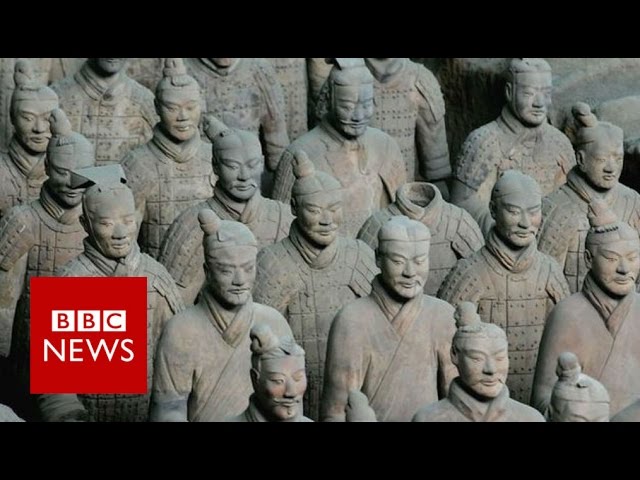The Terracotta Army is a collection of terracotta sculptures depicting the armies of Qin Shi Huang, the first Emperor of China. It is a form of funerary art buried with the emperor in 210–209 BCE with the purpose of protecting the emperor in his afterlife. The figures, dating from approximately the late third century BCE, were discovered in 1974 by local farmers in Lintong District, Xi’an, Shaanxi province. The figures vary in height according to their roles, with the tallest being the generals. The figures include warriors, chariots, horses, officials, acrobats, strongmen, and musicians.
History
The construction of the Terracotta Army began in 246 BCE, soon after the then-King of Qin declared himself the first emperor of a unified China. The figures were crafted to represent the emperor’s army and to serve as his afterlife guard. It is believed that the figures were made with molds and that a single workshop was used to construct them. The figures were made from clay and then fired in kilns.
Discovery
The Terracotta Army was discovered in 1974 by local farmers in Lintong District, Xi’an, Shaanxi province. The figures were found in three pits located approximately 1.5 kilometers east of the Qin Shi Huang’s mausoleum. Upon their discovery, the figures were in a fragmented state, with some of them having been destroyed by the farmers who were digging a well.
Restoration
Since the discovery of the Terracotta Army, the figures have been painstakingly restored. The process of restoration has been ongoing since the figures were discovered and is still ongoing today. The figures have been reassembled and many of the fragments have been replaced with new pieces. Some of the figures have also been painted in order to restore their original appearance.
Significance
The Terracotta Army is considered one of the most significant archaeological finds of the 20th century. The figures provide a unique insight into the military, political, and cultural life of the Qin dynasty. The figures also represent an important aspect of Chinese history and culture, as they depict the first emperor’s attempt to ensure his immortality after death.
Location
The Terracotta Army is located in the Qin Shi Huang Mausoleum Site Museum in Xi’an, China. The museum is open to the public and visitors can view the figures up close and learn more about their history and significance.
Features
The Terracotta Army consists of more than 8,000 life-size figures, including warriors, chariots, horses, officials, acrobats, strongmen, and musicians. The figures vary in height according to their roles, with the tallest being the generals. The figures are all unique and many of them have distinct facial features and clothing. The figures are also equipped with weapons such as swords, spears, and crossbows.
Conclusion
The Terracotta Army is one of the most significant archaeological finds of the 20th century. The figures provide a unique insight into the military, political, and cultural life of the Qin dynasty. The figures are located in the Qin Shi Huang Mausoleum Site Museum in Xi’an, China and are open to the public. The Terracotta Army consists of more than 8,000 life-size figures, including warriors, chariots, horses, officials, acrobats, strongmen, and musicians.


0 Comments